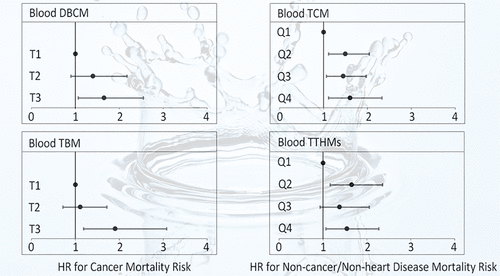当前位置:
X-MOL 学术
›
Environ. Sci. Technol.
›
论文详情
Our official English website, www.x-mol.net, welcomes your feedback! (Note: you will need to create a separate account there.)
Association of Blood Trihalomethane Concentrations with Risk of All-Cause and Cause-Specific Mortality in U.S. Adults: A Prospective Cohort Study
Environmental Science & Technology ( IF 11.4 ) Pub Date : 2021-06-21 , DOI: 10.1021/acs.est.1c00862 Yang Sun 1, 2 , Chen Chen 3 , Vicente Mustieles 4, 5, 6 , Liang Wang 7 , Yu Zhang 1, 2 , Yi-Xin Wang 8 , Carmen Messerlian 1, 2
Environmental Science & Technology ( IF 11.4 ) Pub Date : 2021-06-21 , DOI: 10.1021/acs.est.1c00862 Yang Sun 1, 2 , Chen Chen 3 , Vicente Mustieles 4, 5, 6 , Liang Wang 7 , Yu Zhang 1, 2 , Yi-Xin Wang 8 , Carmen Messerlian 1, 2
Affiliation

|
Water chlorination can lead to the formation of disinfection byproducts, including trihalomethanes (THMs). However, few epidemiologic studies have explored associations between THM exposure and mortality. This study included 6720 adults aged ≥40 years from the National Health and Nutrition Examination Survey 1999–2012 who had blood THM concentrations quantified. A higher risk of all-cause mortality was found across increasing quartile concentrations of blood chloroform (TCM) and total THMs (TTHMs; sum of all four THMs) (both p for trend = 0.02). Adults in the highest quartile of TCM and TTHM concentrations had hazard ratios (HRs) of 1.35 (95% confidence intervals: 1.05–1.74) and 1.37 (1.05–1.79), respectively, for all-cause mortality, compared with adults in the lowest quartile. When cause-specific mortality was evaluated, a positive relationship was found between blood bromodichloromethane (BDCM), dibromochloromethane (DBCM), bromoform (TBM), total brominated THMs (Br-THMs; sum of BDCM, DBCM, and TBM), and TTHM concentrations and risk of cancer death and between blood TCM and TTHMs and risk of other cause (noncancer/nonheart disease) mortality. Our findings suggest that higher exposure to Br-THMs was associated with increased cancer mortality risk, whereas TCM was associated with a greater risk of noncancer/nonheart disease mortality.
中文翻译:

血液三卤甲烷浓度与美国成人全因和特定原因死亡率风险的关联:一项前瞻性队列研究
水氯化会导致形成消毒副产物,包括三卤甲烷 (THM)。然而,很少有流行病学研究探讨 THM 暴露与死亡率之间的关联。该研究包括 1999-2012 年全国健康和营养检查调查中 6720 名 40 岁以上的成年人,他们对血液中的 THM 浓度进行了量化。随着血液氯仿 (TCM) 和总 THMs (TTHMs;所有四种 THMs 的总和) 的四分位数浓度的增加,全因死亡率的风险更高(趋势均为 p = 0.02)。与最低四分位数的成年人相比,TCM 和 TTHM 浓度最高四分位数的成年人的全因死亡率风险比 (HR) 分别为 1.35(95% 置信区间:1.05-1.74)和 1.37(1.05-1.79)四分位数。在评估特定原因死亡率时,发现血溴二氯甲烷 (BDCM)、二溴氯甲烷 (DBCM)、溴仿 (TBM)、总溴化 THM(Br-THM;BDCM、DBCM 和 TBM 的总和)、TTHM 浓度和癌症死亡风险之间存在正相关关系血液 TCM 和 TTHM 以及其他原因(非癌症/非心脏病)死亡的风险。我们的研究结果表明,更多地接触 Br-THMs 与癌症死亡风险增加有关,而 TCM 与非癌症/非心脏病死亡风险更大有关。
更新日期:2021-07-06
中文翻译:

血液三卤甲烷浓度与美国成人全因和特定原因死亡率风险的关联:一项前瞻性队列研究
水氯化会导致形成消毒副产物,包括三卤甲烷 (THM)。然而,很少有流行病学研究探讨 THM 暴露与死亡率之间的关联。该研究包括 1999-2012 年全国健康和营养检查调查中 6720 名 40 岁以上的成年人,他们对血液中的 THM 浓度进行了量化。随着血液氯仿 (TCM) 和总 THMs (TTHMs;所有四种 THMs 的总和) 的四分位数浓度的增加,全因死亡率的风险更高(趋势均为 p = 0.02)。与最低四分位数的成年人相比,TCM 和 TTHM 浓度最高四分位数的成年人的全因死亡率风险比 (HR) 分别为 1.35(95% 置信区间:1.05-1.74)和 1.37(1.05-1.79)四分位数。在评估特定原因死亡率时,发现血溴二氯甲烷 (BDCM)、二溴氯甲烷 (DBCM)、溴仿 (TBM)、总溴化 THM(Br-THM;BDCM、DBCM 和 TBM 的总和)、TTHM 浓度和癌症死亡风险之间存在正相关关系血液 TCM 和 TTHM 以及其他原因(非癌症/非心脏病)死亡的风险。我们的研究结果表明,更多地接触 Br-THMs 与癌症死亡风险增加有关,而 TCM 与非癌症/非心脏病死亡风险更大有关。



























 京公网安备 11010802027423号
京公网安备 11010802027423号